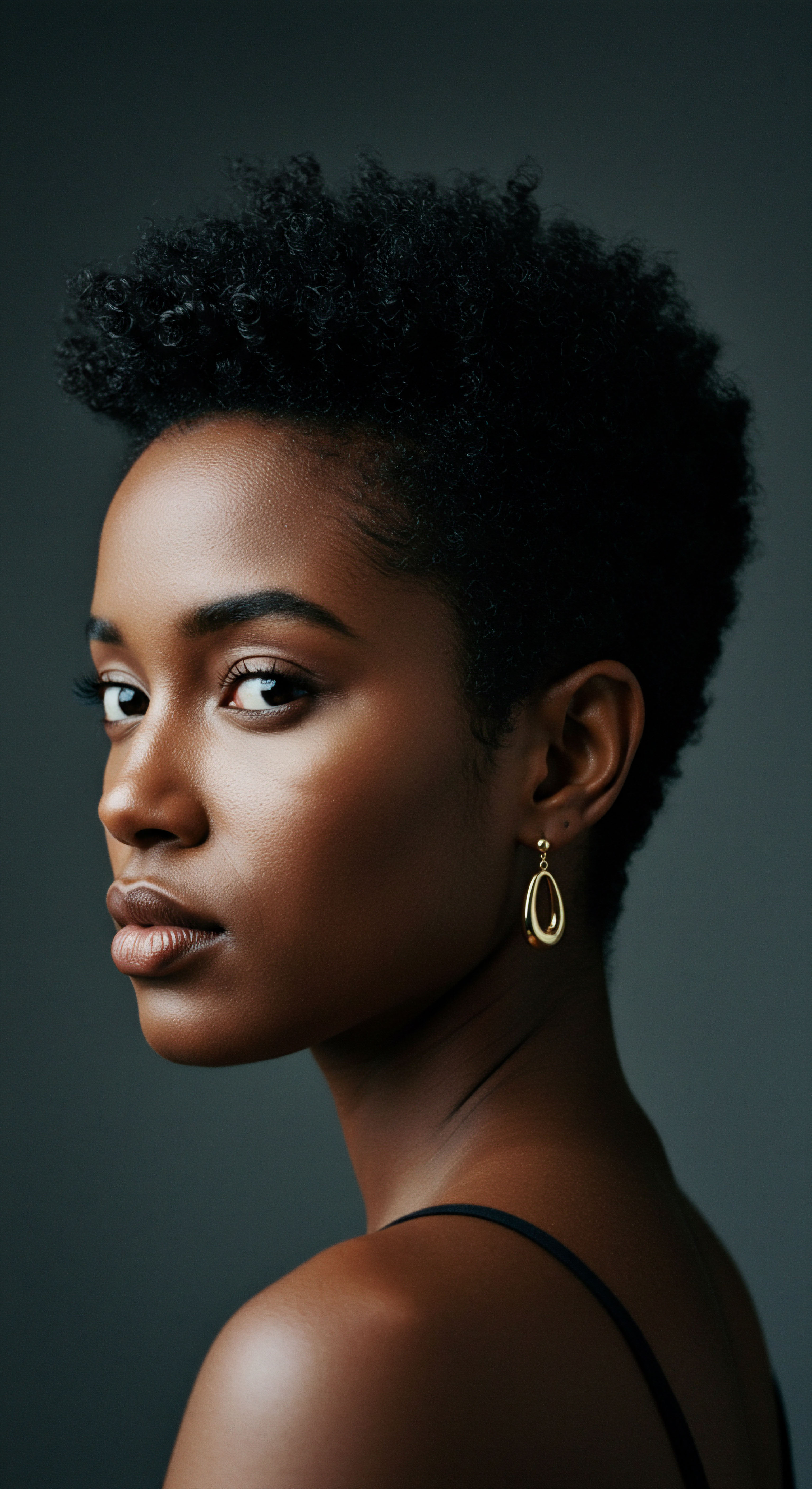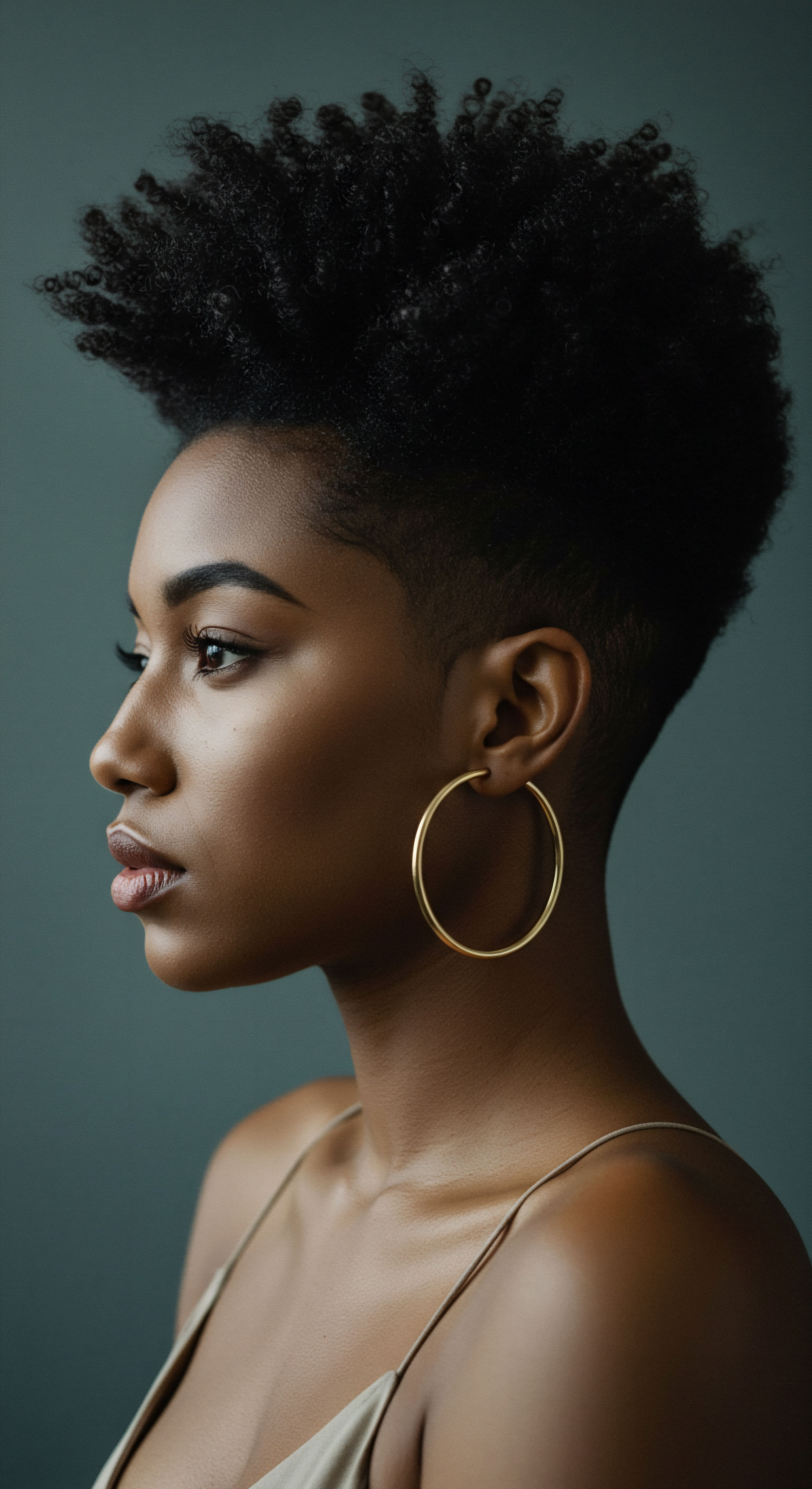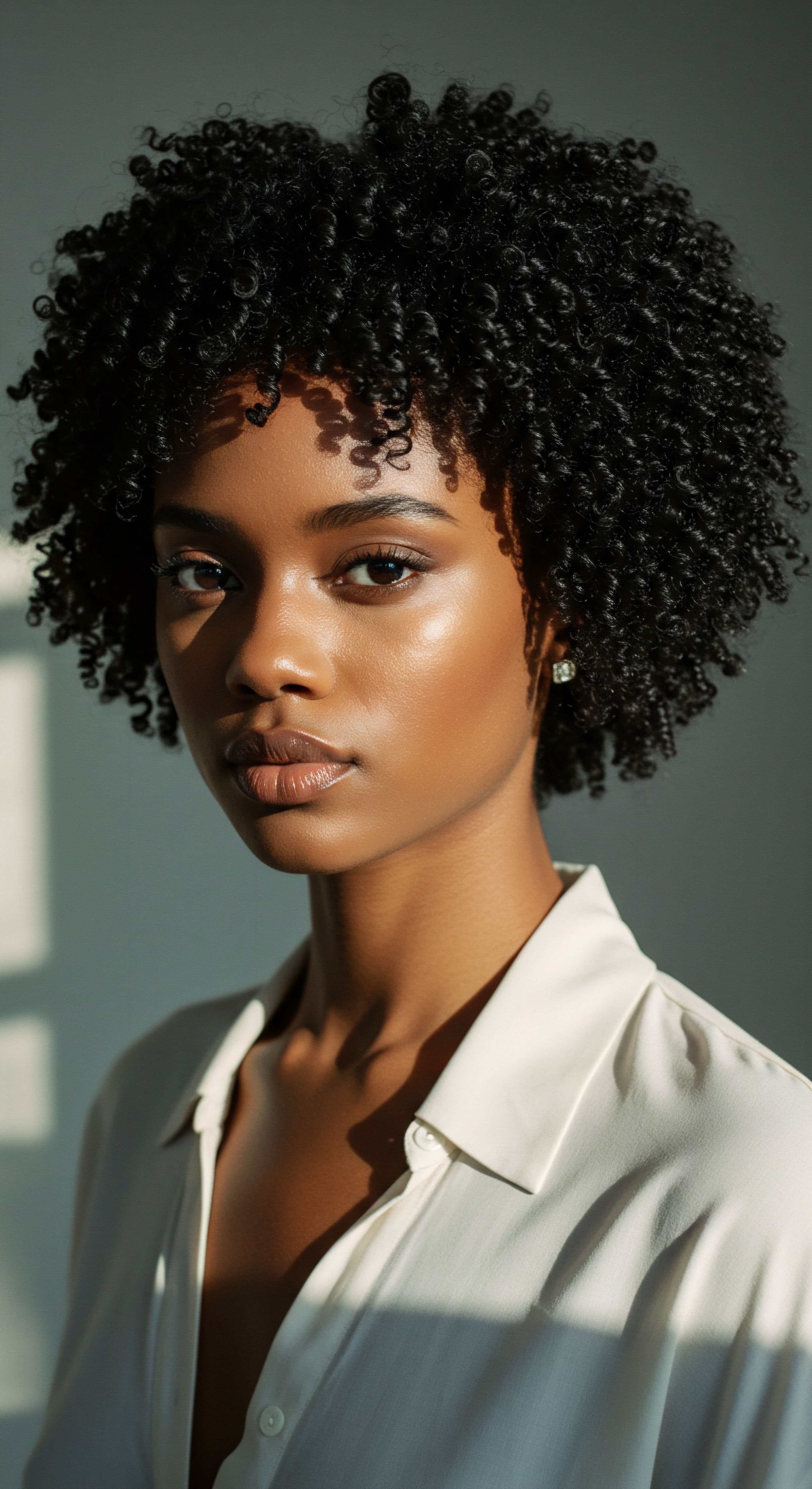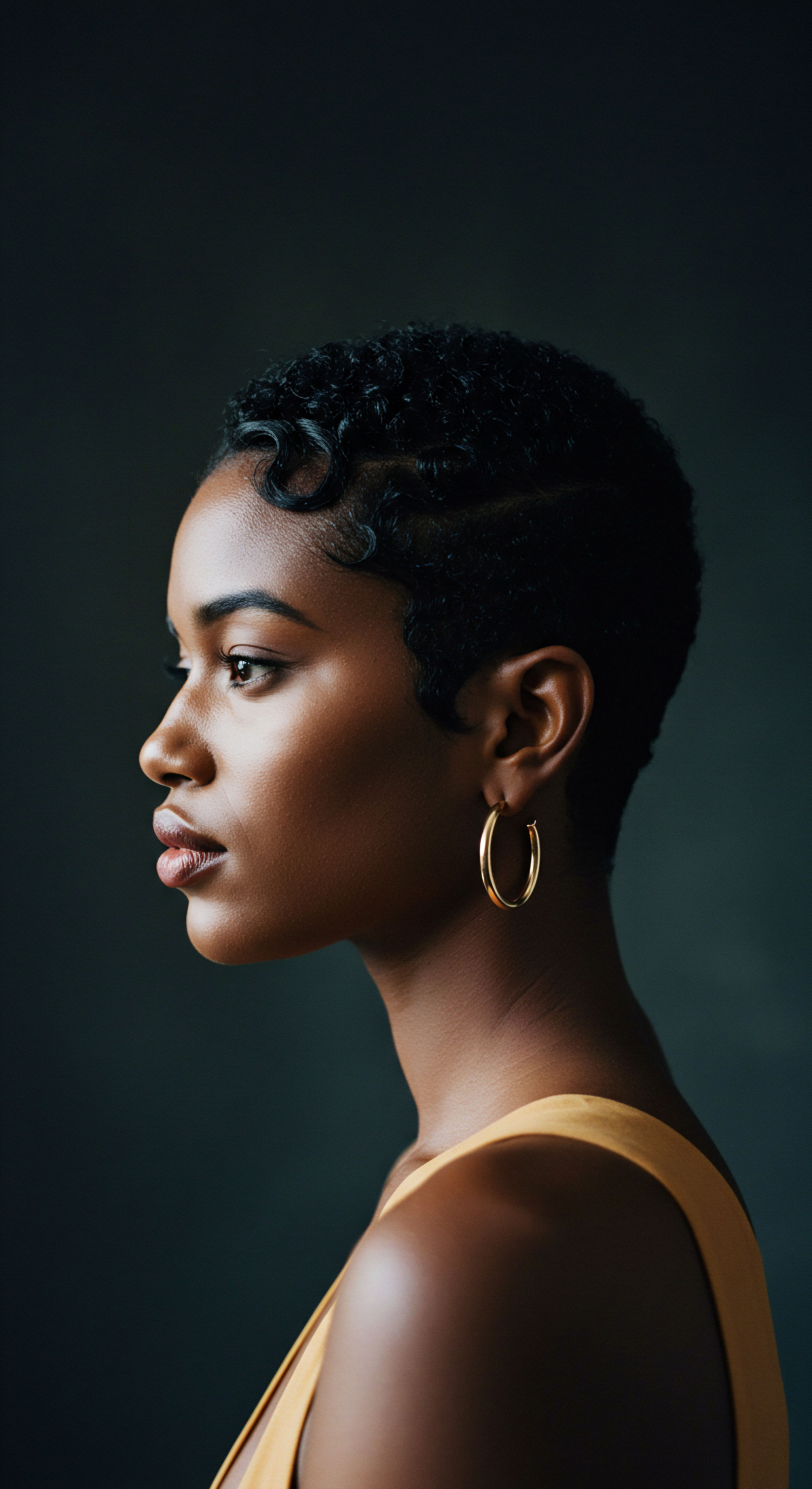
Roots
A quiet wonder often settles when we consider the enduring wisdom passed down through generations. How might the gentle touch of a grandmother’s hands, steeped in traditions as old as time, speak to the vibrant life of textured hair today? This contemplation guides us to the very foundation of our hair’s being, its anatomical blueprint, and the language we use to describe its unique existence. Before we consider any ancient ritual or modern remedy, we must first truly see and acknowledge the hair itself, in all its coiled, curled, and kinky glory.
Understanding the delicate architecture of textured hair is the initial step toward nurturing its vitality. Each strand, though seemingly simple, carries a complex internal world. The hair shaft, emerging from its follicle, comprises three primary layers ❉ the cuticle, cortex, and medulla. For textured hair, the cuticle, the outermost protective layer made of overlapping scales, often sits slightly raised.
This characteristic, coupled with the hair shaft’s elliptical or flattened shape, contributes to its remarkable curl patterns, yet also influences its moisture retention and susceptibility to external factors. The inner cortex, responsible for strength and elasticity, holds the melanin pigments that bestow hair its rich spectrum of hues.

Hair Anatomy for Textured Hair
The distinctive qualities of textured hair begin at the follicular level. Unlike the typically round follicles that yield straight hair, those producing coiled or kinky strands are often elliptical or even ribbon-like. This shape dictates the way the hair grows, curving and spiraling as it exits the scalp. The tight turns and bends within each strand create points where the cuticle can lift, allowing moisture to escape more readily and making the hair feel dry.
This structural reality makes textured hair inherently more prone to breakage than straighter types, requiring a deliberate approach to care that respects its inherent form. The natural oils, known as sebum, produced by the scalp, find it challenging to travel down the intricate twists and turns of coiled strands, leaving the ends particularly vulnerable to dryness.
Understanding the unique anatomy of textured hair is the bedrock for effective care, acknowledging its inherent characteristics.
The presence of disulfide bonds, which lend hair its resilience and shape, also varies. While all hair types possess these bonds, the way they are distributed and the density of their arrangement contribute to the distinctive curl patterns seen in textured hair. This internal composition, alongside the external shape, influences how hair responds to environmental changes, product application, and styling efforts. A deeper acquaintance with these microscopic details allows for a more compassionate and effective care regimen.

How Does Textured Hair Classification Inform Care?
Classifying textured hair goes beyond mere aesthetic observation; it serves as a helpful guide for understanding its needs. Systems like Andre Walker’s typing (1A-4C) offer a common language, though they are broad generalizations. While a type 4C hair, with its tightly coiled Z-pattern, might appear to have less length than a 3A curl, both possess unique strengths and vulnerabilities. The true value of these classifications lies not in rigid categorization, but in their ability to highlight variations in curl tightness, strand thickness, and porosity, which all dictate how products penetrate and how moisture is held.
Consider the spectrum ❉
- Wavy Hair (2A-2C) often possesses a loose S-shape, with varying degrees of body and a tendency toward dryness at the ends.
- Curly Hair (3A-3C) forms distinct spirals, ranging from large, bouncy curls to tighter corkscrews. These strands require regular moisture to prevent frizz and maintain their defined shape.
- Coily Hair (4A-4C) exhibits very tight, small coils or Z-patterns, appearing dense but feeling fine. This hair type is often the most susceptible to dryness and breakage due to its numerous bends and the difficulty of sebum distribution.
This broad categorization helps individuals select products and practices that align with their hair’s general behavior, although individual variations within each type are significant.

The Essential Lexicon of Textured Hair
To speak of textured hair with clarity, a shared vocabulary proves helpful. Beyond curl patterns, terms like Porosity describe the hair’s ability to absorb and retain moisture. Low porosity hair, with its tightly bound cuticles, can resist water penetration but holds moisture well once absorbed.
High porosity hair, with its raised cuticles, absorbs water quickly but loses it just as fast. Understanding one’s hair porosity can guide product selection, favoring lighter humectants for low porosity and heavier sealants for high.
| Term Density |
| Description The number of individual hair strands on the scalp. |
| Relevance to Care Influences product amount needed and styling choices. |
| Term Elasticity |
| Description The hair's ability to stretch and return to its original state without breaking. |
| Relevance to Care Indicates hair health; poor elasticity means brittleness. |
| Term Coily |
| Description Hair with very tight, spring-like curls or Z-patterns. |
| Relevance to Care Often needs greater moisture and gentle handling. |
| Term Humectant |
| Description An ingredient that attracts and holds moisture from the air. |
| Relevance to Care Beneficial for adding hydration to dry hair. |
| Term These terms assist in precise communication about hair needs and responses. |
Other terms, such as Shrinkage, refer to the apparent reduction in hair length when wet due to its coiled nature. While not a sign of damage, it is a common characteristic of textured hair. Knowing these terms allows for more precise conversations about hair health and styling goals, moving beyond generic descriptions to a more specific understanding of individual hair properties.

Hair Growth Cycles and Influencing Factors
Hair growth follows a cyclical pattern, irrespective of texture, though the duration of each phase can vary. The Anagen Phase is the active growth period, followed by the transitional Catagen Phase, and finally the resting Telogen Phase, after which the hair sheds. For textured hair, the anagen phase may be shorter on average compared to straighter hair types, contributing to its perceived slower growth.
Numerous factors influence these cycles. Genetics undeniably sets the blueprint for curl pattern, density, and growth rate. Beyond inherited traits, environmental elements play a role. Diet, hydration, stress levels, and overall health directly impact the nutrients available to hair follicles.
External stressors, such as harsh styling practices or chemical treatments, can prematurely push hair into the resting or shedding phases, hindering optimal growth. A supportive internal environment, nourished by balanced nutrition and calm practices, contributes to a thriving scalp and hair.

Ritual
As we step from the foundational understanding of textured hair, a natural inclination arises to consider the rhythms of care that have long sustained its beauty. What daily gestures, what periodic treatments, might offer true sustenance to modern textured hair? This section explores the practices, both ancient and contemporary, that shape our hair’s well-being, inviting a gentle consideration of how techniques and tools can be thoughtfully applied to support its unique qualities. We look at the methods that bring life to textured strands, guiding us toward a more intentional approach to hair care.
The historical tapestry of hair care reveals a deep connection between cultural identity and styling practices. Across continents and centuries, people have adorned, protected, and celebrated their hair using methods passed down through generations. These traditions often arose from a profound understanding of local flora and environmental conditions, shaping practices that protected hair from harsh sun, dryness, or breakage. Today, many of these ancient techniques find renewed relevance, offering alternatives to modern chemical interventions that sometimes compromise hair integrity.

Protective Styling Encyclopedia
Protective styles, a cornerstone of textured hair care, shield the hair from daily manipulation, environmental stressors, and breakage. These styles tuck away the delicate ends, which are the oldest and most fragile parts of the hair, allowing them to rest and retain moisture. Historically, many cultures developed intricate braiding and wrapping techniques not only for aesthetic appeal but also for hair preservation.
- Braids, such as cornrows, box braids, and twists, have been utilized for centuries across various African cultures. These styles offer length retention by reducing friction and tangling, promoting healthy growth. When installed without excessive tension, they allow for extended periods of minimal handling.
- Twists, including two-strand twists and flat twists, provide a gentler alternative to braids for some, offering similar protective benefits while being easier to install and remove. They are particularly popular for defining curl patterns and retaining moisture.
- Buns and Updos, when styled loosely and without pulling the hairline, can serve as simple yet effective protective measures, keeping hair contained and away from clothing friction.
The success of protective styling hinges on proper installation and maintenance. Overly tight braids or twists can lead to traction alopecia, a form of hair loss caused by prolonged pulling on the follicles. It is essential to ensure that any protective style allows the scalp to breathe and the hair to rest without undue strain. Regular moisturizing of the scalp and hair within these styles is also key to preventing dryness.
Protective styles, when gently applied, offer a respite for textured hair, shielding it from daily stressors and aiding in length retention.

Natural Styling and Definition Techniques
Celebrating textured hair in its natural state involves techniques that enhance its inherent curl, coil, or wave pattern. These methods often draw from principles that honor the hair’s natural inclinations, promoting definition without harsh chemicals or excessive heat.

How Can Coils Be Defined Without Damage?
Defining coils and curls involves working with the hair’s natural propensity to clump. Techniques like the Wash and Go, where hair is cleansed, conditioned, and then allowed to dry with minimal manipulation, often using a curl-defining product, allow the natural pattern to emerge. The Shingling Method, where small sections of hair are individually coated with product and finger-raked to encourage curl formation, offers more precise definition.
The Coil Out or Twist Out involves setting the hair in twists or coils, allowing it to dry, and then carefully unraveling the strands to reveal stretched, defined patterns. These methods rely on the hair’s memory and the right balance of moisture and hold.
The effectiveness of these techniques is greatly influenced by product choice. Water-based conditioners and styling creams that provide slip and moisture are preferred, helping to reduce friction during detangling and product distribution. Avoiding products with heavy, drying alcohols supports the hair’s natural moisture balance. The application of product to wet hair, or hair that is damp but not soaking, helps to seal in hydration and encourage curl formation.

Wigs and Hair Extensions Mastery
Wigs and hair extensions offer versatility and styling options, while also serving as protective covers for textured hair. From ancient Egyptian wigs worn for status and sun protection to contemporary extensions that add length and volume, these accessories have a long and varied history. When used thoughtfully, they can shield natural hair from environmental damage and frequent manipulation.
Mastering their use involves selecting high-quality materials that breathe and ensuring proper installation. For extensions, methods that do not place excessive tension on the natural hair, such as sew-ins with minimal leave-out or clip-ins, are preferred. Wig caps made of satin or silk, rather than cotton or nylon, can help minimize friction and moisture absorption from the hair underneath, preserving its hydration. Regular cleansing and conditioning of the natural hair beneath wigs and extensions remains essential, as does allowing the scalp to air periodically.

Heat Styling and Thermal Reconditioning with a Safety-First Approach
While ancient practices often avoided direct heat, modern life sometimes calls for thermal styling. The desire for straightened or stretched hair is not new; historical methods like pressing combs offered temporary alterations. Today, flat irons and blow dryers offer quick transformations, but their use on textured hair requires extreme caution. The unique structure of coiled strands, with their numerous bends, makes them particularly susceptible to heat damage.
A safety-first approach means prioritizing low heat settings, using heat protectants with every application, and limiting frequency. Excessive or improper heat application can lead to irreversible damage, altering the hair’s natural curl pattern, leading to dryness, and causing breakage. Allowing hair to air dry partially before blow-drying, or opting for tension methods like banding to stretch hair without direct heat, can minimize thermal exposure. The aim is to achieve desired styles with the least possible compromise to hair health.

The Complete Textured Hair Toolkit
The right tools can significantly enhance the hair care experience for textured hair. Many traditional tools, like wide-tooth combs carved from wood or bone, were designed to gently navigate curls without causing undue stress. Today’s toolkit expands on these principles, offering modern innovations alongside time-tested favorites.
Essential tools for textured hair care ❉
- Wide-Tooth Combs ❉ Ideal for detangling wet or conditioned hair, minimizing breakage.
- Denman Brushes or Similar Detangling Brushes ❉ Designed with flexible bristles that help separate curls and distribute product evenly.
- Microfiber Towels or Old Cotton T-Shirts ❉ Gentler than terry cloth towels for drying hair, reducing frizz and preserving moisture.
- Satin or Silk Scarves and Bonnets ❉ Protect hair at night by reducing friction and preventing moisture loss.
- Spray Bottles ❉ Essential for re-wetting hair to apply products or refresh styles without full immersion.
Selecting tools that respect the hair’s delicate nature is as important as choosing the right products. Gentle handling, whether with fingers or appropriate tools, is paramount in preserving the integrity of textured strands.

Relay
How might the enduring wisdom of ancient hair practices truly intersect with the intricate needs of modern textured hair, moving beyond surface-level application to a deeper, more interconnected understanding? This question invites us to consider the scientific underpinnings of historical traditions, examining how biological realities, cultural contexts, and even psychological well-being converge in the pursuit of healthy hair. We look to research and data to illuminate the profound connections between past and present, revealing how time-honored methods offer more than just aesthetic appeal.
The long-standing practices of various cultures often contain empirical wisdom, developed through generations of observation and adaptation. While modern science can isolate compounds and quantify effects, these ancient methods frequently approached hair care as part of a larger wellness system. The challenge, and indeed the opportunity, lies in bridging these perspectives, allowing scientific inquiry to validate or explain the efficacy of traditional approaches, and cultural understanding to inform our appreciation of hair as a marker of identity and heritage.

The Biochemical Resonance of Traditional Ingredients
Many ancient practices relied heavily on botanical ingredients, often prepared in ways that maximized their beneficial properties. Consider the widespread use of fermented rice water across various Asian cultures for hair care. This tradition, dating back centuries, particularly among the Yao women of Huangluo Village in China, is often associated with their remarkable hair length and health. While anecdotal evidence has long supported its use, modern scientific inquiry has begun to unpack its biochemical components.
A study published in the International Journal of Cosmetic Science in 2010 found that fermented rice water contains Inositol, a carbohydrate that can penetrate damaged hair and repair it from the inside out. This compound remains in the hair even after rinsing, offering a protective layer. The study suggested benefits including enhanced elasticity, a smoother texture, reduced friction, and less frizz.
This scientific validation provides a compelling reason why a practice rooted in antiquity continues to gain traction in contemporary hair care discussions. The fermentation process itself can also increase the nutrient density and antimicrobial properties of the rice water, extending its shelf life and enhancing its efficacy.
Ancient wisdom, such as the use of fermented rice water, often holds a surprising scientific basis for its hair-benefiting properties.
Other traditional ingredients, like various plant oils and herbs, also hold scientific merit. For example, coconut oil, used for generations in Indian and African cultures, has been shown to reduce protein loss in both damaged and undamaged hair due to its ability to penetrate the hair shaft. Similarly, amla oil (Indian gooseberry) possesses antifungal properties and is rich in Vitamin C, which can combat oxidative stress linked to hair graying. These examples underscore that ancient practices were not merely superstitions, but often effective methods derived from a deep, albeit intuitive, understanding of natural compounds.

Cultural Context and Hair Health Outcomes
The cultural significance of hair extends beyond its physical attributes, profoundly influencing hair care practices and, by extension, hair health. In many African societies, hair styling served as a marker of identity, status, and spirituality, with elaborate cornrows, threading, and braiding techniques paired with natural butters and herbs for moisture retention. These practices, when performed with care, were inherently protective.
However, the intersection of cultural practices and modern societal pressures can sometimes yield less favorable outcomes. For instance, the widespread adoption of chemical relaxers among Black women, driven by Eurocentric beauty standards, has been linked to various forms of hair loss and scalp conditions. A study comparing Nigerian women with relaxed hair to those with natural hair revealed that women with relaxed hair experienced significantly more flaking of the scalp (P = 0.046), hair breakage (P = 0.023), and hair loss (P = 0.020) than those with natural hair. This data suggests a stark contrast between traditional protective styles and chemical interventions that, while offering a desired aesthetic, can compromise hair health.

Does a Return to Traditional Hair Care Methods Prevent Damage?
The evidence suggests a strong correlation between a return to traditional, gentler hair care methods and improved hair health. The very nature of many ancient practices emphasizes minimal manipulation, natural ingredients, and protective styling. Consider the traditional African methods of using natural butters and oils to seal moisture into hair, often combined with braiding or twisting to reduce daily friction. These methods align perfectly with modern scientific understanding of textured hair’s need for hydration and protection from mechanical stress.
A study comparing hair loss among Andhra and Malayalam girls in India found that Malayalam girls, who adhered to cultural habits of daily head baths with prior oil massage (including hibiscus leaves and egg white application), experienced less hair fall. This indicates that consistent, gentle, and naturally derived practices can indeed contribute to better hair retention and overall scalp health. The emphasis on scalp massage, a common component of many ancient rituals, also promotes blood circulation, potentially aiding follicle health.

The Psychological and Social Dimensions of Hair Practices
Hair care is not merely a physical act; it is deeply intertwined with psychological well-being and social identity. For many, hair is a direct expression of self, heritage, and community. Ancient practices often incorporated communal aspects, where hair styling was a shared activity, fostering bonds and passing down knowledge. This communal aspect, while less common in modern individualistic routines, holds lessons for fostering a healthier relationship with one’s hair.
| Aspect Identity |
| Ancient Practice Influence Hair as a symbol of lineage, status, spirituality. |
| Modern Implication Affirmation of cultural identity, self-acceptance. |
| Aspect Community |
| Ancient Practice Influence Communal grooming, shared knowledge. |
| Modern Implication Building support networks, shared learning. |
| Aspect Self-Perception |
| Ancient Practice Influence Practices tied to natural beauty, strength. |
| Modern Implication Reduced pressure to conform, increased self-esteem. |
| Aspect Stress Reduction |
| Ancient Practice Influence Ritualistic, meditative aspects of care. |
| Modern Implication Mindfulness in routine, self-care. |
| Aspect The interplay between hair care and personal well-being remains a constant. |
The “natural hair movement” in contemporary society reflects a conscious return to practices that celebrate textured hair, often drawing inspiration from ancestral methods. This movement extends beyond product choices; it encompasses a broader shift towards self-acceptance and a rejection of beauty standards that historically marginalized textured hair. By reconnecting with practices that honor their hair’s natural state, individuals can experience a boost in confidence and a deeper connection to their heritage, proving that the influence of ancient practices stretches far beyond the physical strand.

Reflection
The journey through ancient practices and their potential for modern textured hair reveals a compelling narrative of enduring wisdom. It suggests that the path to vibrant, healthy strands is not solely found in the latest scientific breakthroughs, but also in the quiet echoes of ancestral knowledge. The deep understanding of natural elements, the gentle touch of protective styling, and the communal rhythms of care, all offer profound lessons for our contemporary routines. This exploration invites us to consider our hair not merely as a biological structure, but as a living canvas that connects us to history, culture, and our innermost selves, prompting a thoughtful re-evaluation of what truly nourishes and sustains its unique beauty.

References
- Abhilash, S. et al. “Formulation and Evaluation of Fermented Rice Water Herbal Shampoo For Antihairfall Activity.” International Journal of Pharmaceutical Research and Applications, 2023.
- Adewole, A. “Hair Care Practices in African-American Patients.” Seminars in Cutaneous Medicine and Surgery, 2009.
- Sherrow, V. “Encyclopedia of Hair ❉ A Cultural History.” Greenwood Publishing Group, 2006.
- Agbaje, H.O. et al. “Effect of hair care and grooming practices on common scalp disorders and the psychological effect in Nigerian women.” International Journal of Women’s Dermatology, 2021.
- Ali, N. et al. “A Formulation of Rice Water Toner for use of Skin.” Journal of Pharmaceutical Research International, 2025.
- Rao, A. A. K. et al. “Effect of cultural factors on hair fall.” International Journal of Community Medicine and Public Health, 2016.
- Sharma, A. et al. “Formulation and Evaluation of Fermented Rice Water Herbal Shampoo.” ResearchGate, 2021.
- Singh, R. “USE OF RICE WATER (Oryza sativa) & HIBISCUS (Hibiscus rosa-sinensis) FOR HAIR NUTRITION AND HAIR GROWTH.” Journal of Emerging Technologies and Innovative Research, 2021.
- Axe, J. “Rice Water for Hair & Skin ❉ Does It Really Work?” Dr. Axe, 2023.
- Tolliver, S. et al. “Historical Perspectives on Hair Care and Common Styling Practices in Black Women.” Cutis, 2025.
- British Association of Dermatologists. “Caring for Afro-textured hair.” 2021.
- Ogunleye, T. A. et al. “Afro-Ethnic Hairstyling Trends, Risks, and Recommendations.” Cosmetics, 2022.
- National Health Service. “Afro-textured Hair.” St George’s Hospital, 2023.
- Adewole, A. “The Genomic Variation in Textured Hair ❉ Implications in Developing a Holistic Hair Care Routine.” MDPI, 2023.
- Khumalo, N. P. et al. “The Genomic Variation in Textured Hair ❉ Implications in Developing a Holistic Hair Care Routine.” Preprints.org, 2024.
- Rele, A. S. & Mohile, R. B. “Effect of mineral oil, sunflower oil, and coconut oil on prevention of hair damage.” Journal of Cosmetic Science, 22(2), 103-114, 2002.
- Chaudhari, P. & Chaudhari, S. “Hair Oils ❉ Indigenous Knowledge Revisited.” International Journal of Trichology, 2021.
- Goren, A. et al. “Coconut, Castor, and Argan Oil for Hair in Skin of Color Patients ❉ A Systematic Review.” Journal of Drugs in Dermatology, 2022.